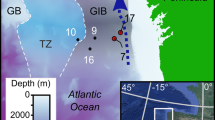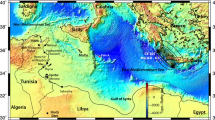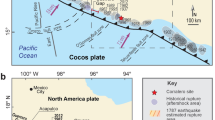Abstract
The sand-dominated Folkestone Beds, widely exposed around the Weald of south-east England, are of Upper Aptian to Lower Albian (Lower Cretaceous) age and range in thickness up to 84 m (refs 1–3). Their content of ammonites, bivalves and sponges indicates a marine origin, while their relative coarseness and the incorporation of drifted timber point to a shallow water deposition near land. One striking sedimentary facies is formed by medium to coarse-grained cross-bedded sands in which several foreset and/or bottomset surfaces support mud drapes. Although it was suggested4 that this facies may have been formed by the storm-induced movement of sand waves, I now consider that the facies is best explained by the migration of sand waves under the influence of strongly asymmetrical tides, and that the mud drapes are formed at slack water. A model of this process has been described elsewhere5 and I now describe measurements of a section which supports my earlier conjecture6that the separation of the mud drapes is systematically related to the phase of the spring–neap tidal cycle at the time of deposition. Although criteria for recognizing tidal deposits have long been available it has not previously been possible to analyse a series of ancient sediments with a view to characterizing the tidal regime.
This is a preview of subscription content, access via your institution
Access options
Subscribe to this journal
Receive 51 print issues and online access
$199.00 per year
only $3.90 per issue
Buy this article
- Purchase on Springer Link
- Instant access to full article PDF
Prices may be subject to local taxes which are calculated during checkout
Similar content being viewed by others
References
Casey, R. Palaeontology 13, 487–621 (1961).
Narayan, J. Nature 199, 1246–1247 (1963).
Narayan, J. Sediment. Geol. 6, 73–109 (1971).
Allen, J. R. L. & Narayan, J. Geologie. Mijnb. 43, 451–461 (1964).
Allen, J. R. L. Sediment Geol. 26, 281–328 (1980).
Allen, J. R. L. Geol. Mag. 117, 437–446 (1980).
McCave, I. N. in Estuarine Hydrography and Sedimentation 170 (ed. Dyer, K. R.) (Cambridge University Press, 1979).
Bagnold, R. A. The Physics of Blown Sand and Desert Dunes, 69 (Methuen, London 1941).
Gadd, P. E., Lavelle, J. W. & Swift, D. J. P. J. sedim. Petrol. 48, 239–252.
Allen, J. R. L. & Friend, P. F. Sedimentology 23, 329–346 (1976).
Doodson, A. T. & Warburg, H. D. Admiralty Manual of Tides, (HMSO, London, 1941).
Scruton, C. T. in Tidal Friction and the Earth's Rotation, 154 (eds Brosche, P. and Sundermann, J.) (Springer, Berlin, 1978).
Lambeck, K. The Earth's Variable Rotation: Geophysical Causes and Consequences (Cambridge University Press, 1980).
Ford, J. G. Mercian Geol. 5, 205–240 (1975).
Author information
Authors and Affiliations
Rights and permissions
About this article
Cite this article
Allen, J. Lower Cretaceous tides revealed by cross-bedding with mud drapes. Nature 289, 579–581 (1981). https://doi.org/10.1038/289579a0
Received:
Accepted:
Issue Date:
DOI: https://doi.org/10.1038/289579a0
This article is cited by
-
Evidence of the Permian marginal marine sedimentation recorded in sub-surface drill cores, Lower Gondwana successions, southern India
Journal of Earth System Science (2022)
-
Characterization of middle Eocene tide-influenced delta: A study from core samples of Hazad Member, Ankleshwar Formation, South Cambay Basin, India
Journal of Earth System Science (2018)
-
Facies characterization of the Surma Group (Miocene) sediments from Jalalabad gas field, Sylhet trough, Bangladesh: Study from cores and wireline log
Journal of the Geological Society of India (2017)
-
The periodic growth increments of biological shells and the orbital parameters of Earth-Moon system
Environmental Geology (2007)
-
Interpretation of tidal bundles: Two reasons for a paradigm shift
Carbonates and Evaporites (2006)
Comments
By submitting a comment you agree to abide by our Terms and Community Guidelines. If you find something abusive or that does not comply with our terms or guidelines please flag it as inappropriate.



